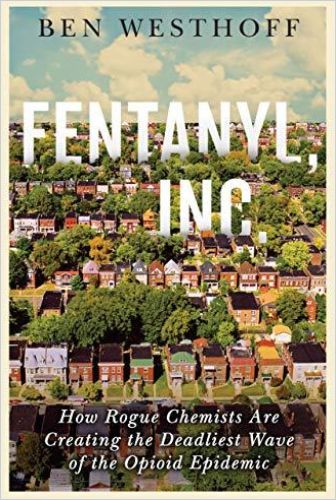Investigative reporter and author Ben Westhoff offers a chilling overview of the scope and profitability of, and corruption within, the world of synthetic opioids.

Death for Profit
How did society go from consuming relatively safe drugs like pot and ecstasy to addictive, lethal synthetic drugs like fentanyl opioids? Investigative reporter Ben Westhoff, who spent four years tracing the origins of the global epidemic, draws a clear line from the drug-makers in China to the cartels in Mexico supplying Western demand, while acknowledging blame on all sides. It’s a grim, but accurate portrait of a powerful motif in contemporary American life: addiction. Westhoff argues that no war on drugs can succeed, and that the United States should adopt the harm-reduction practices of Europe and Canada.
Yahoo Finance, The Daily Telegraph, Kirkus Reviews, Buzzfeed and The St. Louis Post-Dispatch all chose this as one of their Best Books of the Year. The National Book Review called it, “Extensively reported and vividly written.” USA Today found it, “Timely and agonizing.” And Dig Boston said, “The most frightening book of the year, and it’s mandatory reading.”
Fentanyl Kills
Westhoff comes right to the point: The synthetic drug fentanyl – many times more powerful than heroin – fuels America’s worst-ever drug epidemic and kills more Americans than crack, methamphetamine, car accidents or shootings.
Heroin is strong stuff, but fentanyl is just completely on another level.Ben Westhoff
Most users aren’t seasoned addicts, and often have no idea of fentanyl’s potency; they overdose and die with alarming frequency.
Fentanyl, like heroin, comes from opium, but, Westhoff clarifies, laboratories develop it chemically.
Today, black market opioids account for most overdose deaths. But pharmaceutical companies, the author insists, including Purdue, must take much of the blame for the crisis. Westhoff reveals that as prescription drug deaths leveled off, many addicts switched to powerful synthetics, leading to high-profile opioid overdose victims such as Prince.
NPS
The scientists who create synthetics – “novel psychoactive substances” (NPS) – may do so in the hope of producing beneficial drugs, but, Westhoff makes clear, people always find ways to use the substances for illicit purposes. He cites the drug inventor, Alexander Shulgin, who first synthesized MDMA – the active ingredient in ecstasy – in the mid-1960s. Westhoff notes that this happiness drug has few side effects, and offers potential for treating post-traumatic stress disorder (PTSD) and other psychological ailments, but the Drug Enforcement Administration (DEA) banned it in 1985.
The danger isn’t just in the drugs themselves but in the fact that nobody knows how much they should be taking.Ben Westhoff
Chemist Paul Janssen discovered fentanyl in 1959. Fentanyl and its analogs fueled drug addictions and overdose deaths across Europe and Russia, where, Westhoff laments, manufacturers create large quantities. He explains that victims overdose because dealers mix fentanyl into heroin, coke, meth and ecstasy.
China
US drug dealers trade in fentanyl through the dark web, and get their drugs from China. The DEA and US Customs try to stop shipments through the mail – the largest conduit for synthetics – but, the author states, they inspect only a small fraction of the more than a million foreign packages which come through daily.
Mexico, Westhoff discovered, supplies the majority of the fentanyl-laced heroin in the United States. They also handle most of the meth, which garners – with many of the drugs or precursors from China – hundreds of millions of dollars annually. Drugs coming from Mexico typically pass through official border crossings or enter the United States via tunnels; Westhoff is adamant that border walls make no difference.
Westhoff portrays networks of Mexican cartel members moving the drugs by car, using small-time dealers to reach users. These gang members, he stresses, blend in and eschew violence. But Mexican cartels cut fentanyl into heroin inconsistently, so neither dealers nor users know its potency.
Yuancheng – perhaps the largest Chinese drug manufacturer – sells the precursors NPP and 4-ANPP to buyers in Mexico and the United States; it operates under enormous subsidies from the Chinese government.
Whereas China has been at least somewhat responsive to American requests to control its chemical industry, India has trailed when it comes to scheduling NPS and fentanyl precursors.Ben Westhoff
And, Westhoff relates, India supplies the African and the Middle Eastern opioid trade. India’s production of fentanyl and fentanyl precursors lags China’s, but, the author warns, it could easily ramp up.
War on Drugs
Westhoff runs down the United States’ futile wars on drugs, which began when President Richard Nixon declared the first in 1971. Ronald Reagan introduced Draconian penalties; and Bill Clinton added the “three-strike” rule, which resulted in life sentences for thousands of nonviolent drug offenders.
It’s clear that despite federal spending in the billions of dollars, and unparalleled resources given to local enforcement, the war on drugs – with the goal of eliminating drugs from American life – has not worked and will not succeed.Ben Westhoff
Westhoff bemoans the drug-related murders of more than 120,000 people in Mexico and the $58 billion spent annually on drug law enforcement measures – none of which slow the flow of drugs.
Harm Reduction
Westhoff offers a productive alternative to the current, failing US strategies: In Europe, authorities work with nonprofits and other agencies to educate drug users and test the purity of drugs. These policies have resulted in a 90% lower rate of overdose deaths than in the United States.
He names Energy Control, a drug testing operation that European governments fund, as the best harm-reduction operation in the world. By ending restrictions on ecstasy and other traditional drugs, Spain, likewise, all but eliminated overdose deaths.
Vernacular
Westhoff combines a hard-edge street vernacular with in-depth, rigorous reporting. This gives his prose an intimate feel, as if he were sitting next to you in a bar, telling what he knows. Thus, despite its immense detail, the book remains an accessible page-turner – though you may need time to digest the full horror of what he reports. Until Westhoff discusses harm reduction, he offers scant good news and vivid portraits of personal, corporate and governmental greed, all preying on addicts helpless in the face of increasingly powerful substances.
Ben Westhoff also wrote Original Gangstas; Dirty South; and New York City’s Best Dive Bars. Other telling works on opioids and America’s epidemic of addiction include Beth Macy’s Dopesick and Sam Quinones’s Dreamland.




